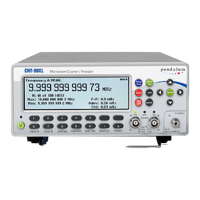FREQ C
CNT-90/91(R)
With an optional prescaler the counter can
measure up to 3, 8, 15 or 20 GHz on Input C.
These RF inputs are fully automatic and no
setup is required.
CNT-90XL
The four versions cover the frequency ranges
27, 40, 46 and 60 GHz by means of an
automatic down-conversion technique
described on page 4-12. Faster (manual)
acquisition is an alternative if the measured
frequency is fairly known. Then its nominal
value can be entered via the keyboard as a
fixed starting point for the acquisition process.
Note: Some frequencies may not be acquired
correctly with Auto Acquisition. If so, switch
to Manual Acquisition instead.
An additional feature is the possibility to
measure signal power with high resolution.
RATIOA/B, B/A, C/A,
C/B
To find the ratio between two input frequen-
cies, the counter counts the cycles on two
channels simultaneously and divides the result
on the primary channel by the result on the
secondary channel.
Ratio can be measured between Input A and
Input B, where either channel can be the pri-
mary or the secondary channel. Ratio can also
be measured between Input C and Input A or
between Input C and Input B. Here Input C is
the primary channel.
Note that the resolution calculations
are very different as compared to
frequency measurements. See page
8-55 for details.
BURST A, B, C
A burst signal as in Fig. 4-2 has a carrier
wave (CW) frequency and a modulation
frequency, also called the pulse repetition
frequency (PRF), that switches the CW signal
on and off.
Both the CW frequency, the PRF, and the
number of cycles in a burst are measured
without external arming signals and with or
without selectable start arming delay. See
Chapter 5 "Measurement Control" for a fun-
damental discussion of arming and arming de-
lay.
The general frequency limitations for the re-
spective measuring channel also apply to
burst measurements. The minimum number of
cycles in a burst on Input A or Input B is 3
below 160 MHz and 6 between 160 MHz and
400 MHz (using Manual Trigger). Burst mea-
surements on Input C involve prescaling, so
the minimum number of cycles will be 3 x
prescaling factor. The 3 GHz option, for ex-
ample, has a prescaling factor of 16 and re-
quires at least 48 cycles in each burst.
The minimum burst duration is 40 ns below
and 80 ns above 160 MHz.
Triggering
Bursts with a PRF above 50 Hz can be mea-
sured with auto triggering on.
The out-of-sync error described under heading
"Possible errors" on page 4-6 may occur more
frequently when using A
uto Trigger.
When PRF is below 50 Hz and when the gap
bet
ween the bursts is very small, use manual
triggering.
USER MANUAL ● CNT 9x Series ● Rev.22 February 2020

